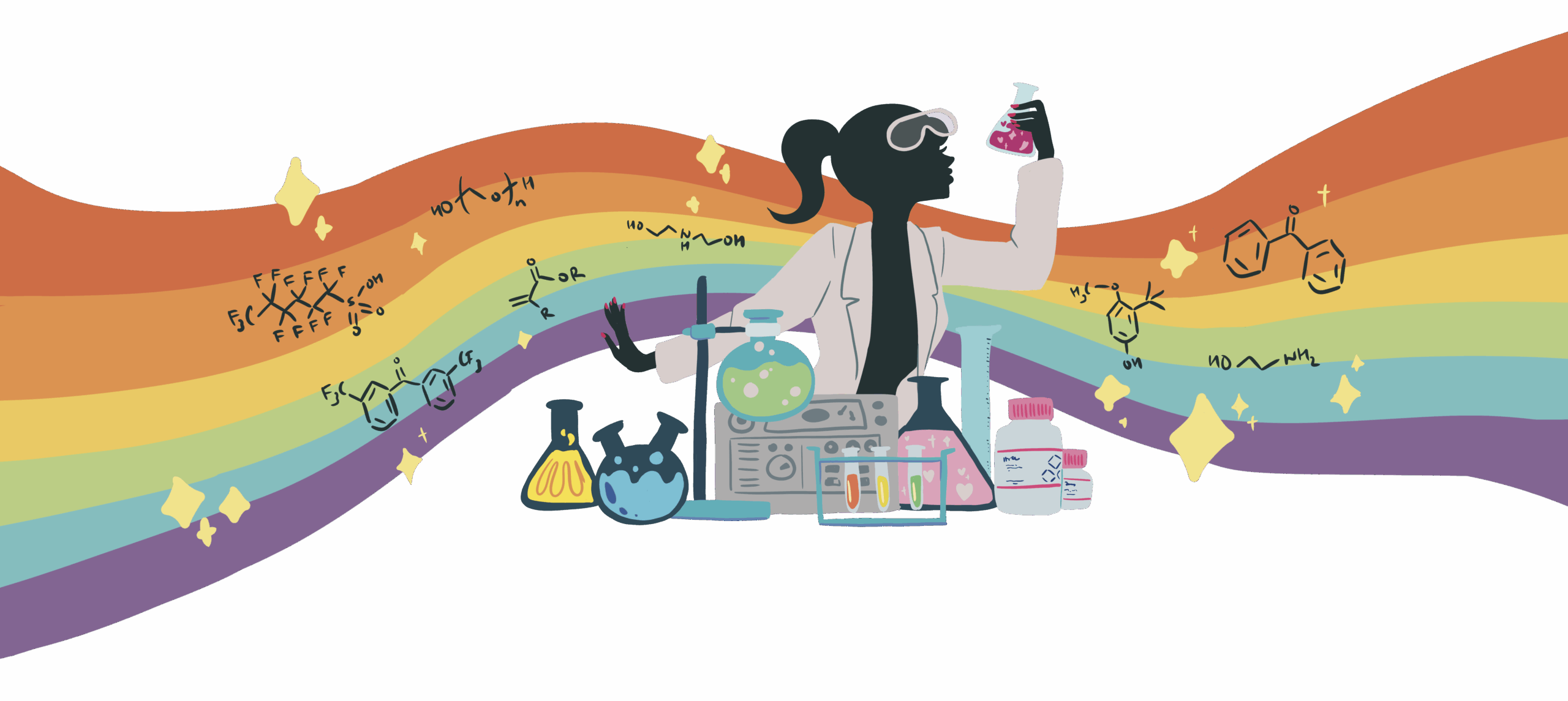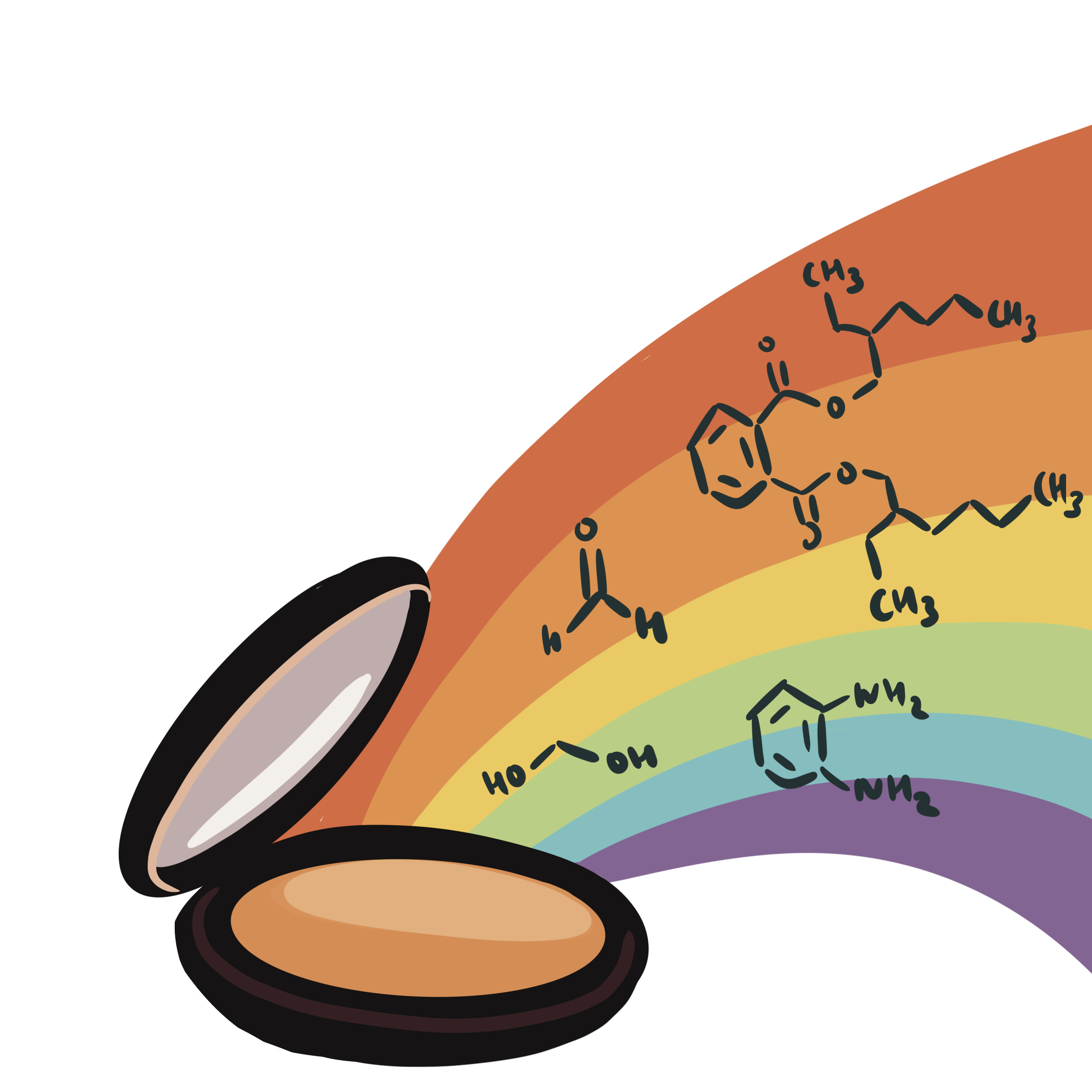
Beauty is in the Eye of the Beaker: Introducing Cosmetic Chemistry
WRITTEN BY TIFFANY SAFAR
ILLUSTRATED BY YALE HUANG
Have you ever wondered what your favorite powder blush is made of? Pink pigment? Reflective glitter? Pixie dust straight from the esteemed Pixie Hollow tree? Why of course! Those are all crucial ingredients, but you’re missing something else: the actual chemical compounds making up the product.
This is one of the many queries addressed by cosmetic chemists, a group of scientists who not only see the beauty in chemistry, but make use of chemistry to accentuate ours. Cosmetic chemists are the minds behind the products sitting on your vanity like skincare, makeup, fragrance, and nail polish. Similar to the over-the-counter drugs found at your local CVS, cosmetic products are developed by formulators who act as principal scientists in a production pipeline, ultimately culminating in a shade match at Sephora.
Like other pharmacological fields, cosmetic chemistry studies how chemicals favorably interact with the body, with a goal of creating safe, effective, and—in this case—alluring products for all to use. So if you’re majoring in chemistry, chemical engineering, or a similar discipline, you’re already on the right track to enter the cosmetic chemistry space. Here at UC San Diego, courses like organic chemistry, analytical chemistry, and polymeric materials provide you with the necessary educational background and laboratory skills to approach chemical synthesis and product development.
After finishing undergraduate courses, there are many avenues students can take to prepare themselves down the line. Some aspiring cosmetic chemists obtain advanced degrees or certifications in cosmetic science. These programs are available worldwide and cover topics like personal care science, cosmetic technology, and quality assessment to accurately represent the product formulation process from start to finish. Other students who are interested in opening their own cosmetic business can obtain a Master’s in Business Administration (MBA) to cultivate a comprehensive understanding of product research and marketing to cater their formulations to a broader audience.
Several aspiring cosmetic chemists begin their careers as formulation technicians, who work under senior scientists and develop goods with a variety of applications. Formulating items like cosmetics, pharmaceuticals, and household supplies utilizes an attentive and considerate lens that guarantees products are versatile for the general public.
Product formulation begins like any other research project in academia or industry: by thoroughly assessing the background information of a particular topic. In the context of cosmetics, this is characterized by studying similar products and analyzing customer preferences, such as a chemist examining the hues, texture, and blendability of blushes released by other companies. This not only provides a good launchpad for product development, but allows formulators to see where improvements can be made.
From here, chemists list the goals of their desired products to ensure wide consumer usability and enjoyment. Should the blush have a dewy or matte finish? Buildable coverage? Cool-toned or warm-toned colors? What skin types is the blush compatible with? These questions act as a guide for ingredient selection and ultimately the rest of the formulation process.
Now comes the fun part. To actually produce a powder blush, cosmetic chemists begin with two fundamental ingredients. The first of the two is white base powders or fillers, like talc, mica, sericite, or kaolin. White powders (no, not those ones) improve color adherence and oil absorption when applied to the skin. The second and arguably most important ingredient of powder blush is the colorants or pigments that actually add color to the product. Common colorants in blush formulas are iron oxides and carmine, which add a range of red and brown tones. If chemists want a blush with a nice sheen, translucent pearls can be supplemented alongside pigments. Different types and amounts of base powders and pigments can be added to meet the formulators’ goals for the tone and texture of their desired blush.
Once the right combination of ingredients is achieved, cosmetic chemists refine their formulation through several product considerations. Adding diverse chemical compounds creates a well-rounded product that not only lasts throughout the day on the skin but also for months of storage on a customer’s vanity. Binders or compacting agents like zinc stearate and esters can be added to ensure the blush doesn’t break in its compact with continued use. Product longevity is supported with the inclusion of preservatives like phenoxyethanol and methylparaben, which prevents pesky microbial growth. Supplementing antioxidants like Vitamin E and BHA hinders color change attributed to oxidation, promising that blush shades stand the test of time.
Putting themselves in the shoes of consumers, scientists assess what ingredients would not only improve product stability, but certify consumer safety for daily use. To justify adding these ingredients, chemists carry out product evaluations, which are routinely performed in the cosmetic chemistry space whether a new product is being developed or a pre-existing formula is being modified. These tests can be done in vitro (in a laboratory) or in vivo (on live volunteers) and validate formulations before they are packaged and sold. For a powder blush, testing can measure how the blush formula performs on different skin types and assesses volunteer preferences of hue and texture. The individual components also undergo quality control testing with analytical chemical techniques and later the final formulation undergoes packaging compatibility testing. Once a product has passed these tests with flying colors, then voila! It’ll be available at your local CVS or Sephora to purchase.
The beauty of developing cosmetics (pun intended) is the formulation process’s limitless potential. If a company has a certain vision for a product, they have all of the tools needed at an arm’s reach. Just as a makeup artist can use a single eye shadow palette to create endless looks, cosmetic chemists tap into their ingredient catalog and knowledge of chemistry to create novel and aesthetically pleasing products.
Cosmetic chemistry harnesses the various chemical properties of ingredients and the chemistry of skin, hair, and nails to meet in the middle and make well-considered products for all to use. So the next time you put on your makeup or apply your fragrance, silently thank the cosmetic chemists out there who added that color pigment or synthetic fragrance or pixie dust into the mix!

References
- Building Up Chemicals in Cosmetics: Blush. https://www.linkedin.com/pulse/building-up-chemicals-cosmetics-blush-tradeasia-international/ (accessed 2025-03-28)
- Castro, F.; Cornwell, P. Introduction to Product Evaluation for Cosmetic & Personal Care Products – Bite-Sized Learning. TRI Princeton. https://www.triprinceton.org/post/introduction-to-product-evaluation-for-cosmetic-personal-care-products-bite-sized-learning (accessed 2025-04-03)
- Glow by Ramón. What’s in your makeup? How blush and pressed products are made. Youtube, December 11, 2023. https://www.youtube.com/watch?v=N5szTSnDivI
- How to Become a Cosmetic Chemist (With Steps). https://www.indeed.com/career-advice/finding-a-job/how-to-become-cosmetic-chemist (accessed 2025-03-27)
